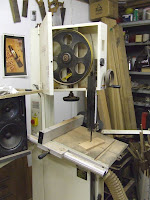







Finishing is a tricky subject – it can make or break a project. There are many different finishes, and almost as many different ways to apply them. After using most of the types of finish available I find myself reaching for the Shellac nine times out of ten.
So what is shellac? It is a resin excreted by the Lac bug which feeds on braches of certain trees. The resin is harvested and then purified – the different levels of purification give different shades of shellac, from dark brown through to clear. It is dissolved in alcohol (methylated spirit is fine) and by varying the amount of alcohol to shellac (or the “cut”) you can get different strength solutions (i.e. thicker for bodying up).
Shellac has some excellent traits :
For me one of the best things about shellac is its versatility – you can wipe on a single thing coat to seal the timber against fingerprints (think Jim Krenov’s method of finishing) or you can continue to add layers of finish to get the desired sheen or thickness. And the speed with which it dries means you can make some serious progress – no waiting overnight for the finish to cure. Only a couple of minutes are needed for it to be dry.
Ease of application is another plus – I’ve used paper towels, rags, mini-rollers and brushes. You can also spray it, but I’ve never felt the need to.
So what downsides are there to shellac? Well, it is dissolved in alcohol, so shellac probably wouldn’t make the best finish for a bar top – a few splashed drops of whiskey would spell disaster. Its also not water proof, so is only suitable for indoor use. But that’s about it.
Shellac is a wonderful finish for wood – it brings out the beauty of the grain and figure and makes it shine. It is a natural finish that has been used for centuries and just looks “right”. My favourite technique is to apply a coat of oil to the piece, buff it dry and then apply shellac. This gives a deep shine and makes the figuring jump out at you. And its quick and easy to do!
One final comment – there are many different shades of shellac. Experiment with them on different colour timbers – I love garnet on walnut, and lemon adds an interesting “vintage” tint to most timbers.
